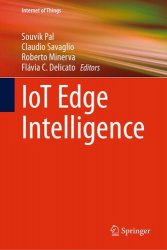IoT Edge Intelligence
- Добавил: literator
- Дата: 8-06-2024, 02:31
- Комментариев: 0
 Название: IoT Edge Intelligence
Название: IoT Edge IntelligenceАвтор: Souvik Pal, Claudio Savaglio, Roberto Minerva
Издательство: Springer
Серия: Internet of Things
Год: 2024
Страниц: 392
Язык: английский
Формат: pdf (true), epub
Размер: 28.4 MB
This book explores fundamental and advanced concepts related to the AI-enabled Edge Technology paradigm, also known as Edge Intelligence, within the framework of the Internet of Things (IoT). Expanding the application of Edge computing is increasingly necessary. This can involve exploring automated, intelligent computational learning theorems, and ANN-oriented, trustworthy machine learning perspectives to enhance computational intelligence. The book functions as a valuable resource for professionals in the sector and also acts as a comprehensive learning tool for newcomers in the field of AI-enabled Edge Technologies and their applications, covering both fundamental and advanced concepts. This book uses data and network engineering and intelligent decision support system-by-design principles to design a reliable IoT edge-cloud ecosystem and to implement cyber-physical pervasive infrastructure solutions. The book will help readers understand the design architecture and AI algorithms and learn analytics through IoT edge, device-edge and the state-of-the-art in cloud-IoT countermeasures. The book is a valuable reference for anyone doing undergraduate or postgraduate studies, conducting research, or working in the computer science, information technology, electronics engineering, and complicated mathematical modeling domains.
Edge Intelligence (EI) has been defined as the confluence of edge computing and Artificial Intelligence (AI). An edge intelligence system (EIS)—a system that supports and utilizes edge intelligence—draws from these fields and from many other fields, depending on the driving of applications. As such, edge intelligence systems also inherit the modeling, simulation, and evaluation challenges from their driving applications. The development and proliferation of EIS have resulted in a plethora of new applications and solutions to challenging problems—including, but certainly not limited to, smart home systems, autonomous vehicle fleets, intelligent manufacturing systems, natural disaster detection systems, and smart agriculture. Such deployments range from having homogenous devices connected over homogeneous networks executing simple Machine Learning (ML) algorithms to heterogeneous, dynamic networks of heterogeneous devices with a range of capabilities executing complex or optimized ML algorithms. Whether simple or complex, the design, development, and modeling of edge intelligence systems requires the integration of different physical and functional components.
Contents:
Скачать IoT Edge Intelligence
Внимание
Уважаемый посетитель, Вы зашли на сайт как незарегистрированный пользователь.
Мы рекомендуем Вам зарегистрироваться либо войти на сайт под своим именем.
Уважаемый посетитель, Вы зашли на сайт как незарегистрированный пользователь.
Мы рекомендуем Вам зарегистрироваться либо войти на сайт под своим именем.
Информация
Посетители, находящиеся в группе Гости, не могут оставлять комментарии к данной публикации.
Посетители, находящиеся в группе Гости, не могут оставлять комментарии к данной публикации.

